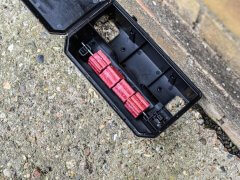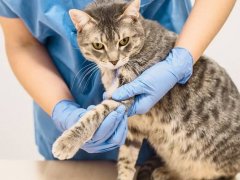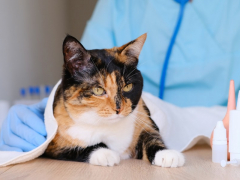
There is almost nothing scarier than realizing your pet is choking and unable to breathe. In this article, you’ll learn how to look for signs that your cat is choking, causing airway compromise. You’ll learn steps to perform the Heimlich maneuver. When performed timely and properly, it may save your cat’s life.
Signs Your Cat is Choking
Choking is obviously a very scary thing to experience. Like people, especially small children, choking in cats most commonly occurs due to a piece of food or a foreign object being lodged.
It’s important to realize that if a cat is choking and cannot breathe, they can’t really comprehend or process what’s going on. They simply know they can’t breathe and are likely to respond in a very reactionary manner, being panicked and scared.
While people can learn the international sign for choking to indicate to others that they need help, your cat can’t do that and you have to try to recognize the issue, and quickly. Following are 8 signs that may be seen in a choking cat.
One of these alone may not be enough as they can be seen with other things, but at least 2 or 3 seen together may indicate your cat is in distress and needs immediate help.
- Coughing: it’s important to recognize that this will look different than a typical asthmatic cough, or what some confuse with a cat “coughing” up a hairball. Cornell University has a great diagram of what a cat with this type of cough commonly looks like with a characteristic crouched posture, extended neck, tongue out, while expelling (usually several in a row) wheezy coughs.
- A choking cough will not be a regular expelling of air as with a wheeze but more of a gagging wet, struggling kind of cough.
- Gagging or retching: this action appears as a cat opening their mouth like they’re trying to expel something, but nothing comes out. This may happen over and over again. The difference from vomiting is that gagging at least will not involve the typical series of full abdominal compressions before a cat vomits up food or a hairball.
- Salivation: an acute onset of excessive salivation, especially combined with other signs in this list, can suggest that something is stuck in the throat. Cats may salivate for other reasons including nausea or if they ingested something that tasted awful.
- Acting panicked or distressed: a choking cat will often act in a distressed or frenzied manner. A cat may make some short bursts through the house, alternating with signs in this list like gagging, pawing at their face, or rolling around, desperate to clear their airway.
- Pawing at the mouth: a choking cat may try to paw at their head or mouth in a futile attempt to get whatever it is out. Cats don’t have the ability to truly reach into their mouth, so what you’ll see may be more of a pawing, slapping, or clawing type of action around their face and mouth.
- Rubbing their head on the floor in a distressed manner: this may be another manner of attempt for a cat to dislodge something. This will usually be combined with pawing at their mouth and other items in this list.
- Writing or contorting the body: I have encountered choking cats that act almost like they’re having a kind of seizure or fit. This is a panic or struggle response to having a blocked airway.
- Cyanotic (blue/grey) gums: Cyanosis occurs when oxygen is severely lacking. Seeing cyanosis can mean that choking has been going on longer and quick, efficient emergency care is needed.
It may be hard to differentiate these signs from other conditions that may appear similar. What’s important to remember is that choking cats often can’t expel any air (as an asthmatic cat can still do) and will not be able to vocalize (as you may see with other conditions causing pain or distress).
It’s also helpful to know the context of the situation, if you’re aware of it. Here are some questions to ask. If you can answer “yes” to one or more of these, choking may be possible along with the signs above.
- Was this an acute onset situation?
- Was your cat acting completely normal only moments before?
- Was your cat in the act of eating something when this started?
- Was your cat chewing on something (toy, string, plastic, etc.) when this started?
Why Try the Heimlich Maneuver?
If you’re convinced your cat is choking or at least have good evidence to suspect it, asphyxiation from lack of air can occur in only a couple minutes at most. While you will still need to take your cat to the vet if you dislodge the object as we’ll discuss later on, it is too likely your cat will pass out from lack of air and die by the time you reach your vet.
Sadly, I have encountered cases where even when a cat owner snatches up their cat immediately upon seeing something is wrong, a 5-7 minute trip to the vet is too long to save their life when they arrive. CPR is rarely successful in pets if it is not started immediately upon loss of consciousness from not being able to breathe.
So while the Heimlich does present potential risks to you and your cat, the possibility of dislodging an object and clearing their airway can outweigh those risks if the maneuver saves their life.
Heimlich Maneuver Steps
Warning: A choking cat that cannot breathe will be in distress. Catching, holding, and restraining may be difficult. Attempting the Heimlich maneuver in a cat can save their life but can carry risk for personal injury from being scratched or bitten.
1. Try to dislodge the object

Notice how the index finger is curved like a hook. This is to try to loosen/dislodge an object but avoid pushing it further into the throat. Chris Vanderhoof and Bart / Cats.com
- Lay your cat on their side. It helps to squat or sit around their hindquarters so they can’t back up away from you.
- Open your cat’s mouth by holding their upper jaw with your thumb and forefinger
- Lower the lower jaw with your other hand
- Sweep across with a finger to see if you can feel or dislodge an object.
Be careful to sweep, not push your finger in. Pushing too far back may instead push an object further back into the throat, making it harder to get out.
2. If you cannot feel or dislodge an object

The shaved area is the belly. Both fists overlap on the belly, just under the ribcage. A squatting or kneeling position may be easier than standing. Chris Vanderhoof and Bart / Cats.com
- Lift your cat with their spine/back against your chest or stomach
- Make a fist that fits into the hollow just behind their last rib
- Clasp your other hand over your fist
- Make quick upward thrusts 5 times into the hollow.
- If your cat is struggling and you cannot hold firmly this way, hold your cat by the scruff with one hand, using just one fist for thrusts.

If your cat is amenable to scruffing, this method may work best to control your cat’s position while giving thrusts. Chris Vanderhoof and Bart / Cats.com
Use quick, firm thrusts but not excessive force. Being too strong or forceful can carry risk for internal injury.
3. If the object does not come out

Again, take note of the finger being curved to loosen an object but not force it further back. Vanderhoof and Bart / Cats.com
- Suspend your cat by the hips with their head hanging down and try sweeping the mouth again.
4. If the object still does not come out

The method of bracing the cat against your thigh will provide more stability for using the heel of your other hand to provide short but firm blows to the back over the shoulder blades. Credit: Chris Vanderhoof and Bart / Cats.com
- With your cat still oriented with their head hanging down, pin them against your chest and deliver 5 sharp blows to their back between the shoulder blades with the palm of your hand.
- Alternatively, you can brace their belly/chest on your thigh, hold the scruff of their neck, and perform the same motion.
Again, use quick, firm motions but avoid excessive force. Being too strong or forceful can carry risk for internal injury.
5. Repeat steps 1-4 until the object is dislodged.
If you are unsuccessful after 2-3 minutes or if your cat loses consciousness, begin rescue breathing and CPR and get your cat to the closest veterinary hospital. It is best if two people go together, with one person to drive and the other to continue rescue breathing and CPR.
What to Do After: The Danger of Noncardiogenic Pulmonary Edema
If you do manage to dislodge an object using the Heimlich maneuver on your cat, you’re not completely out of the woods. You will still need to get your kitty to the closest veterinary hospital as soon as possible.
The reason is that the act and struggle of choking can lead to a condition called noncardiogenic pulmonary edema (NCPE). This describes fluid build-up in the lungs in the absence of heart disease (otherwise the most common reason for fluid build-up in the lungs, or pulmonary edema).
NCPE occurs from choking episodes due to the massive release of stress hormones called catecholamines which damages lung tissue. Upper airway obstruction also causes increased lung capillary pressure and increased permeability (leakiness) of blood vessels.
Treating NCPE properly involves a doctor understanding the right history and context (i.e. a recent choking event just occurred).
Sedation, even if mild, is commonplace when assessing a cat after a choking event. A cat may still be extremely panicked and agitated and continued stress can continue to contribute to NCPE.
Sedation and analgesics (pain-relievers) can also help to facilitate getting chest x-rays, an important part of evaluating NCPE and its severity. There is a specific pattern of fluid congestion on x-rays that is different from what we might see with heart failure or pneumonia.
Some vets may also be skilled enough with ultrasound to assess the lungs accurately for pulmonary edema, which can be less stressful than the process of taking x-rays.
Treating NCPE is mostly supportive. Oxygen therapy is the most important part, along with reducing stress. Properly equipped emergency hospitals will have a special treatment cage designed to provide high levels of oxygen.
Any veterinarian can provide at least some limited oxygen support. If there’s evidence your cat may need more intensive oxygen support because of NCPE, they may recommend having your cat transferred to a better-equipped facility when they’re more stable.
Medications we often use for heart failure, pneumonia, or severe asthma show little evidence of benefit in treating NCPE.
In most cases, where there are no additional complicating conditions (such as heart disease) a cat with NCPE after a choking event can recover completely in 24-48 hours.
-
Animal Emergency Center. (n.d.). Signs Your Cat is Choking & What to Do. Animal Emergency Center Pet Care Know-Hows.
-
Coastal Care Veterinary. (n.d.). Veterinary Emergencies: Choking Pets. Coastal Care Veterinary Emergency and Referral Hospital.
-
C Mandell, D. (n.d.). How to Help a Cat Choking. American Red Cross Training Services.
-
O’Brien, C. (2019, May 6). What to Do if Your Cat is Choking. Hill’s.
-
Case, J. (2023, May 9). Heimlich Maneuver in Cats: How to Perform Heimlich Maneuver if a Cat is Choking. petMD by Chewy.
-
Unger, K., & Martin, L. G. (n.d.). Noncardiogenic pulmonary edema in small animals. Journal of Veterinary Emergency and Critical Care. https://doi.org/10.1111/vec.13278
-
Bach, J. (2011, August 1). Non-cardiogenic pulmonary edema. DVM360.
-
E Pachtinger, G. (2013, June). Noncardiogenic Pulmonary Edema. Clinician’s Brief.







